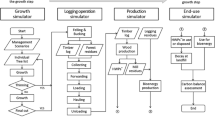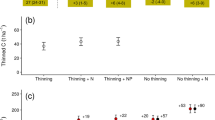Abstract
A forest carbon (C) sequestration project was conducted to evaluate the economic incentives that would be required by landowners to engage in C trading under different management regimes. Costs associated with joint management for C sequestration and timber would be valuable for establishing sound forest C trading systems. In this study, we calculated the C yield and amortized value of three Wyoming, ponderosa pine stands. The management practices examined were, unmanaged, even-aged (regeneration after clear-cut) and uneven-aged (selectively harvested). Costs and revenues associated with three stands were converted into 2006 real dollars using the all commodity producer price index to facilitate a comparison among the net revenues of three stands. Net revenues were annualized using a conservative annual interest rate of 4.5%. Our even-aged stand had the highest annual average C yield of 2.48 Mg·ha−1·a1, whereas, the uneven-aged stand had the lowest C accumulation (1.98 Mg·ha−1·a−1). Alternatively, the even-aged stand had the highest amortized net return of $276·ha−1·a−1 and the unmanaged stand had the lowest net return of $64 ·ha−1·a−1. On the plots examined, an annual payment of $22 for each additional Mg of C sequestered would encourage a change from uneven aged management to an unmanaged stand that sequesters additional C, in the absence of transactions costs.
Similar content being viewed by others
References
Antle J, Capalbo S, Mooney S, Elliott E, Paustian K. 2003. Spatial heterogeneity, contract design, and the efficiency of carbon sequestration policies for agriculture. Journal of Environmental Economics and Management. 46: 231–250.
Birdsey RA. 1996. Carbon storage in United States forests. In: R. N. Sampson, and D. Hair (eds.), Forests and Global Change, Vol. II: Opportunities for Improving Forest Management, American Forests, Washington, DC. pp. 23–39
Boldt CE, Alexander RR, Larson MJ. 1983. Interior ponderosa pine in the Black Hills. In: R.M. Burns (ed.), Silvicultural Systems for the Major Forest Types of the United States. Agricultural Handbook 445. Washington, D.C., USA, pp 80–83.
Boyland M. 2006. The economics of using forests to increase carbon storage. Canadian Journal of Forest Research, 36: 2223–2234.
Calderia K, Morgan MG, Baldocchi D, Brewer PG, Chen C-TA, Nabuurs G-J, Nakicenovic N, Robertson GP. 2004. A portfolio of carbon management options. In: C.B. Field, M.R. Raupach (eds.), The global carbon cycle: integrating humans, climate, and the natural world. Washington, DC.: Island Press, pp. 103–129
Chatterjee A. Vance GF, Tinker DB. 2009. Carbon pools of Ponderosa and Lodgepole pine forests. Canadian Journal of Forest Research, 39:1893–1900.
Chicago Climate Exchange. 2009. Forestry carbon emission offsets. Available online at http://www.chicagoclimatex.com/content.jsf?id=242; last accessed March 17, 2010.
Haynes RW. 2003. An Analysis of the Timber Situation in the United States: 1952 to 2050. USDA For. Serv. Gen. Tech. Rep. PNW-GTR-560. Portland, OR. 254 pp.
Huang C, Kronard GD. 2001. The cost of sequestering carbon on private lands. Forest Policy and Economics, 2: 133–142.
Lippke B, Perez-Garcia J. 2008. Will either cap and trade on carbon emissions tax be effective in monetizing carbon as an ecosystem service. Forest Ecology and Management, 256: 2160–2165.
Mooney S, Antle J, Capalbo S, Paustian K. 2004. Design and costs of a measurement protocolfor trades in soil carbon credits. Canadian Journal of Agricultural Economics, 52: 257–287.
Mooney S, Gerow K, Antle J, Capalbo S, Paustian K. 2007. Reducing standard errors by incorporating spatial autocorrelation into a measurement scheme for soil carbon credits. Climatic Change, 80: 55–72.
Pohjola J, Valsta L. 2007. Carbon credits and management of Scots pine and Norway spruce stands in Finland. Forest Policy and Economics, 9: 789–798.
Sampson RN., 2002. Monitoring and measuring wood carbon. Presented at the Colorado SWCS Conference on Carbon as a Potential Commodity, Denver, CO. Available at http://www.sampsongroup.com/Papers/carbon.htm; last accessed Feb. 6, 2007.
Sedjo RA, Wisniewski J, Sample AV, Kinsman JD. 1995. The economics of managing carbon via forestry: assessment of existing studies. Environmental and Resource Economics, 6: 139–165.
Sheppard WD, Battaglia MA. 2002. Ecology, silviculture, and management of Black Hills ponderosa pine. USDA For. Serv. Gen. Tech. Rep. RMRSGTR-97. 112 pp.
Thornley JHM, Cannell MGR. 2000. Managing forests for wood yield and carbon storage: a theoretical study. Tree Physiology, 20: 477–484.
Tinker DB, Stakes GK, Arcano RM. 2009. Allometric equation development, productivity, and biomass partitioning in managed and unmanaged ponderosa pine stands, Black Hills, Wyoming. Western J Appl For, (Submitted)
Turner MG, Tinker DB, Romme WH, Kashian DM, Litton CM. 2004. Landscape pattern of sapling density, leaf area, and aboveground net primary production in postfire lodgepole pine forests, Yellowstone National Park (USA). Ecosystems, 7: 751–775.
Author information
Authors and Affiliations
Corresponding author
Rights and permissions
About this article
Cite this article
Chatterjee, A., Mooney, S. & Vance, G.F. Comparisons of carbon pools and economic profitability for managed ponderosa pine stands in Wyoming, USA. Journal of Forestry Research 21, 482–486 (2010). https://doi.org/10.1007/s11676-010-0102-3
Received:
Accepted:
Published:
Issue Date:
DOI: https://doi.org/10.1007/s11676-010-0102-3




